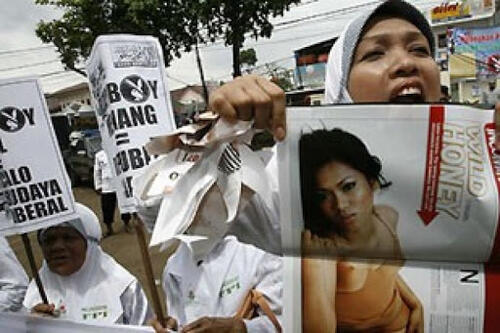Grappling With The Profane in Post-Soeharto Indonesia

Grappling With The Profane in Post-Soeharto Indonesia
Justine Fitzgerald’s article “You wan see jiggy-jig?” describes the turmoil in Indonesia as the country grappled with the resurgence of accessible pornography at the turn of the 21st century. In Soeharto’s Indonesia, pornography was difficult to come by, mostly due to censorship and the belief that its existence desecrated family values. Pornography has been thought of as one of the main causes of “teenage promiscuity,… rape and AIDS,” although there has been no supporting evidence. Indonesian law defines pornography as “as being anything that offends public morals,” and the vague definition allows any slightly sexual media to be defined as pornography and censored. However, in the post-Soeharto era, the creation and dissemination of pornographic material has become easier and has opened up a gateway to corruption and exploitation. Costs of pornographic material have skyrocketed although quality has remained low and continues to propagate sexist stereotypes that are consumed by increasingly younger audiences.
The groups that make up KMAP (Anti-Pornography Community Consortium) typically subscribe to Islamic values or aim to address the exploitation of women. However, their method of addressing pornography typically provides minimal penalties and looks away from the offenses of imporant or rich participants. KMAP fails to address to structure of anti-pornography laws and exploitation concerns, preferring to sue the media and symbolically burn pornographic materials. This type of anti-pornography activism has been faulted with ignoring the discourse around other matters of sexuality in Indonesia outside of the “sensationalistic reporting of rape cases and celebrity sex scandals”. The channels for control of pornography have been undermined by their own inefficacy and the establishment of alternate channels for pornographic and sexual exposure, such as chat rooms, literature, and articles. Interestingly enough, some materials have begun to target women as consumers and create new markets for a female audience.
The Indonesian government has no control over pornography, but there has been both an increase in Islamic rhetoric about morality and pushes for more freedom of speech and expressions of female sexuality. Both groups insist that lines need to be drawn that acknowledge the erotic but limit the dissemination of offensive pornographic materials. This article was interesting to me since many societies have been grappling with the effects of pornography, especially in the light of feminism and growing efforts to validate sex work and end the exploitation of sex workers. The article only briefly acknowledged that some sex workers are voluntarily participating in the system and want to be respected as laborers and paid for their work. My interests lie primarily in the complex sphere of sex work in Southeast Asia and how it will be handled. The arena of female agency and control over female sexuality and its intersection with labor seems to have gone unaddressed in this article. The exploitation of women that frequently occurs in pornography without the explicit knowledge of consumers went unaddressed as well, as the article preferred to focus on the exploitation of consumers with recent price gouging. I would like to know how the situation has developed in the past two decades and if the dissemination of pornographic material has ramped up, especially against the backdrop of Islamic morality and increased liberalism. I would also like to know about changes in how sex work is viewed, policed, and addressed in Indonesian culture and media since Soeharto’s rule.
Comments
Raisha,
You really capture the tension inherent to these kinds of developments in the post-Suharto era. On the one hand, there are dangers associated with top-down moralizing about sexuality and sex work that get entangled with critiques of pornography. Connected to this, as you note, are the ongoing debates in Indonesia about fundamentalism, shariah law and other developments. On the other hand, there are serious concerns about the exploitation of women, objectification and other things that can make this stroy extremely complicated and demands precisely the kind of layered and nuanced perspective you are starting to articulate here.
Pages